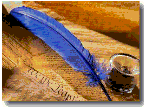
The Declaration of Independence
When in the course of human events . . .
The Sons of Liberty
In Boston in early summer of 1765 a group of shopkeepers and artisans who called themselves The Loyal Nine, began preparing for agitation against the Stamp Act. As that group grew, it came to be known as the Sons of Liberty. And grow it did! These were not the leading men of Boston, but rather workers and tradesmen. It was unseemly that they would be so agitated by a parliamentary act. Though their ranks did not include Samuel and John Adams, the fact may have been a result of a mutually beneficial agreement. The Adams' and other radical members of the legislature were daily in the public eye; they could not afford to be too closely associated with violence, neither could the secretive Sons of Liberty afford much public exposure. However, amongst the members were two men who could generate much public sentiment about the Act. Benjamin Edes, a printer, and John Gill of the Boston Gazette produced a steady stream of news and opinion. Within a very short time a group of some two thousand men had been organized under Ebenezer McIntosh, a South Boston shoemaker.
The first widely known acts of the Sons took place on August 14, 1765, when an effigy of Andrew Oliver (who was to be commissioned Distributor of Stamps for Massachusetts) was found hanging in a tree on Newbury street, along with a large boot with a devil climbing out of it. The boot was a play on the name of the Earl of Bute and the whole display was intended to establish an evil connection between Oliver and the Stamp Act. The sheriffs were told to remove the display but protested in fear of their lives, for a large crowd had formed at the scene. Before the evening a mob burned Oliver's property on Kilby street, then moved on to his house. There they beheaded the effigy and stoned the house as its occupants looked out in horror. They then moved to nearby Fort Hill were they built a large fire and burned what was left of the effigy. Most of the crowd dissipated at that point, however McIntosh and crew, then under cover of darkness, ransacked Oliver's abandoned home until midnight. On that evening it became very clear who ruled Boston. The British Militia, the Sheriffs and Justices, kept a low profile. No one dared respond to such violent force.
By the end of that year the Sons of Liberty existed in every colony. Their most popular objective was to force Stamp Distributors throughout the colonies to resign. The groups also applied pressure to any Merchants who did not comply with the non-importation associations. Wherever these groups existed they were either directed in secret by leading men in the community or actually lead by them. However, there were opportunists everywhere, too, who would use the name Sons of Liberty to carry out acts of revenge and other violence not related to the cause. For example, in South Carolina a group of sailors, calling themselves The Sons of Liberty, formed a mob to coerce money from people on the streets*. Such behavior could certainly undermine the cause, so the Sons spent a great deal of time policing themselves and pretenders. This was the origin on names such as "True Sons," and "True-born Sons" of Liberty.
The success of these movements in undermining the Stamp Act cannot be attributed to violence alone. Their most effective work was performed in newsprint. A great many of the Sons were printers and publishers themselves and even those who were not, were sympathetic to the cause. It was they who would pay the most in duties, after all. Nearly every newspaper in the colonies carried daily reports of the activities of the Sons. Accounts of the most dramatic escapades spread throughout the colonies. In one most remarkable incident, an account of the Virginia Stamp Act Resolutions was printed far and wide. It is not certain how many of the editors who reprinted it were aware of the status of the resolutions, but seven were printed, while only five actually passed (the fifth was in fact rescinded the day after adoption.) The ultimate effect of such propaganda was to embolden both citizens and Legislatures in every colony. When the Stamp Act became effective on the 1st of November, 1765, nearly all of these papers went right on publishing without the required Stamp.
In the early months of 1766 there was such chaos that many of the royal governors had gone into hiding. The Sheriffs and Militia that they might have counted on to keep the peace were mostly members of the Sons of Liberty. Governors were afraid to unlock the weapons stores. Few royal troops were available and they were vastly outnumbered in any case. The Sons of Liberty had displaced the royal government in nearly every colony. The Stamp Act Congress had concluded its business, but there was little hope that its petition to Gr. Britain would be heard. Correspondence between the various groups began, toward the mutual support and defense of the cause. It was expected that eventually British troops would land and attempt to reassert control. So it was that the first efforts to unite the colonies were not undertaken by their respective legislatures, but by these independent radical groups. The various Sons throughout the colonies began to correspond and develop a larger organization.
Start page | The Document | Signers | Related Information | Jefferson's Account | Declaration House | Declaration Timeline | Rev. War Timeline | More Resources |





